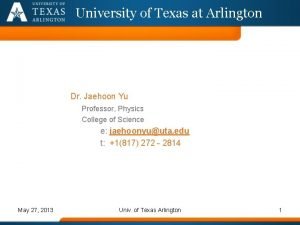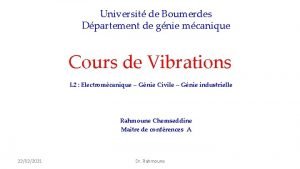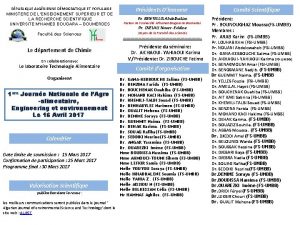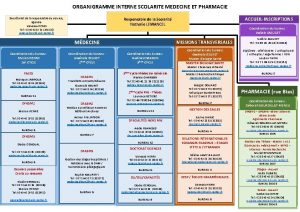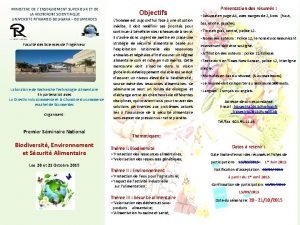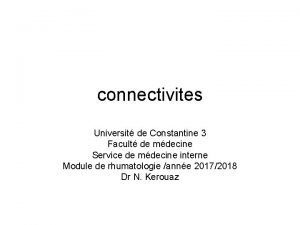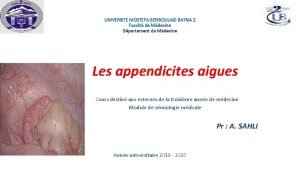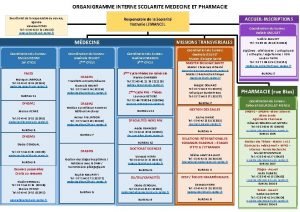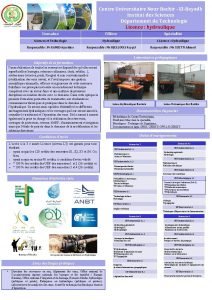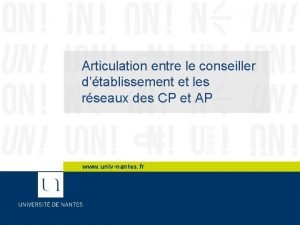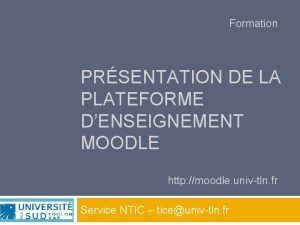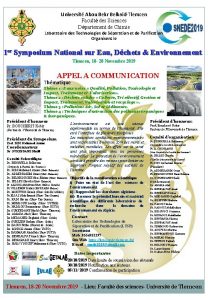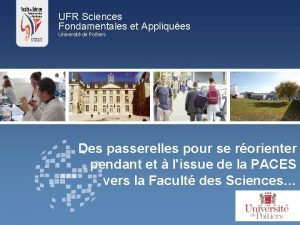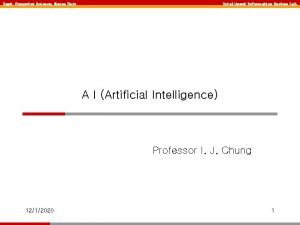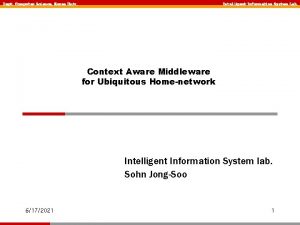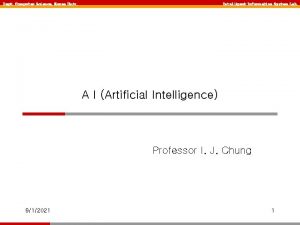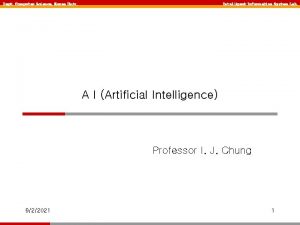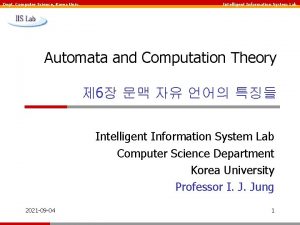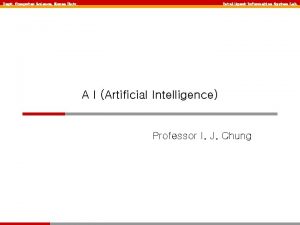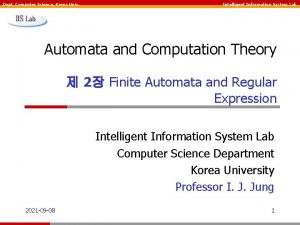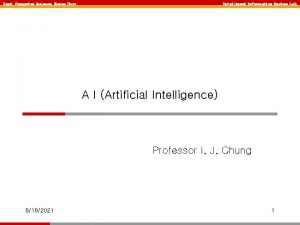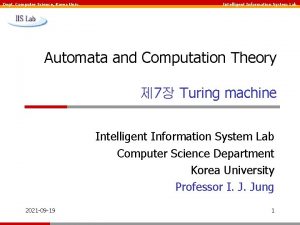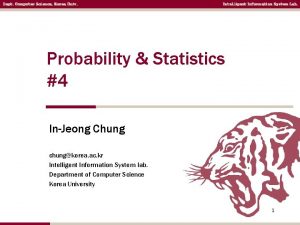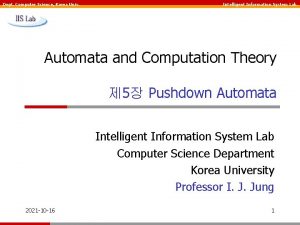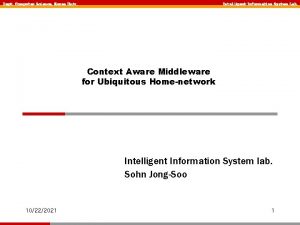Dept Computer Science Korea Univ Intelligent Information System


















- Slides: 18

Dept. Computer Science, Korea Univ. Intelligent Information System Lab. Probability & Statistics #1 In-Jeong Chung chung@korea. ac. kr Intelligent Information System lab. Department of Computer Science Korea University 1

Dept. Computer Science, Korea Univ. Intelligent Information System Lab. 1. 1 Basic Concepts n Experiment any process where outcome is not known in advance with certainty ■ Note : probability theory is based on possible outcomes & events that might occur when an experiment is performed n Random experiment ■ Experiment where the outcome of experiment can’t be predicated with certainty n Sample space (Outcome space) ■ Collection of all possible outcomes of an exp. n Event (Set) ■ Subset of sample space 2

Dept. Computer Science, Korea Univ. Intelligent Information System Lab. 1. 1 Basic Concepts ■ e. g. Tossing a die : S = {1, 2, 3, 4, 5, 6} § Random variable X : a real-valued function defined on the sample space S § i. e. X is a function which assigns a real # X(s) for ∀ possible outcome s ∈ S ■ e. g. Tossing a coin : Consider an experiment of tossing a coin with 10 times § S : 210 different sequence of Head & Tail § i. e. S = {<H 10>, <H 9 T>, … , <T 10>} § X(s) = 4, if random variable X is a function which assigns the # of heads obtained on 10 tosses and s = H 2 T 3 H 3

Dept. Computer Science, Korea Univ. Intelligent Information System Lab. 1. 1 Basic Concepts ■ e. g. Consider a point in the xy-plane, and an experiment of selecting a point in the xy-plane § Random variable X(s) : x-coordinate of the chosen point, § Random variable Y(s) : y-coordinate of the chosen point, § Random variable Z(s) : distance from the origin of the plane to the point 4

Dept. Computer Science, Korea Univ. Intelligent Information System Lab. 1. 1 Basic Concepts n Set algebra with the event & sample space ■ A, B : subset of sample space ■ A 1, … , Ak : mutually exclusive events, exhaustive ■ Probability P(A) : P ∈ [0, 1] & P is the change that event A happens or occurs where A ⊂ sample space § Note : P(A) = 1 : the event A happens(occurs) always P(A) = 0 : the event A never happens 5

Dept. Computer Science, Korea Univ. Intelligent Information System Lab. 1. 1 Basic Concepts ■ Note : 6

Dept. Computer Science, Korea Univ. Intelligent Information System Lab. 1. 1 Basic Concepts ■ e. g. Ex 1. 1. 10 Amsterdam train Paris Brussels train § P(A∪B) : the probability that at least one train is on time. § i. e. the fafaculty will meet at least one student in pair 7

Dept. Computer Science, Korea Univ. Intelligent Information System Lab. 1. 2 Methods of Enumeration n Permutation n! : ■ Arrangement of n different objects with a particular order § Permutation of n different objects taken r at a given time n Combination : ■ Choice of objects without consideration ordering of among the objects n Multiplication rule : ■ Consider some sequence of experiments E 1, … , Ek with outcomes n 1, … nk, respectively, then the experiments can occur altogether 8

Dept. Computer Science, Korea Univ. Intelligent Information System Lab. 1. 2 Methods of Enumeration ■ e. g. R B G linearization 3! = 6 § C 1, C 2, … , Ck : k balls with different color § K! ways of linearization ■ e. g. from 26 alphabet characters, ∃ 26 P 3 different 3 -letter code words 9

Dept. Computer Science, Korea Univ. Intelligent Information System Lab. 1. 2 Methods of Enumeration ■ e. g. from 10 persons selection of president, vice president, secretary, a treasurer n Sampling with replacement : ■ Some object is selected from the population & then replaced before the next object is selected n Sampling without replacement : ■ Some object is selected from the population & once it is selected, it will not be replaced any more 10

Dept. Computer Science, Korea Univ. Intelligent Information System Lab. 1. 2 Methods of Enumeration n The total # of possible ordered samples of size r taken from n objects on the sampling with replacement = nr ■ ∵ use the multiplication rule, ■ The # of ordered samples from n objects ■ e. g. when we roll a die 10 times, the # of possible ordered samples = 610 11

Dept. Computer Science, Korea Univ. Intelligent Information System Lab. 1. 2 Methods of Enumeration ■ e. g. 1 2 … 10 10 balls in an urn : ■ Suppose we select 6 balls with replacement, then # total # of possible ordered samples = 106 ■ The total # of possible ordered samples of size r taken from n object in the sampling without replacement ∃ n samples on the 1 st selection ∃ n-1 samples on the 2 nd selection ∃ n-2 samples on the 3 rd selection : 12

Dept. Computer Science, Korea Univ. Intelligent Information System Lab. 1. 2 Methods of Enumeration ■ e. g. 1 2 … 10 select 6 balls without replacement § Combination of n objects taken r at a time § Permutation : selection of r objects from n objects with a certain ordering § Combination : selection of r objects from n objects without a certain ordering 13

Dept. Computer Science, Korea Univ. Intelligent Information System Lab. 1. 2 Methods of Enumeration ■ e. g. ∃ 20 m/c of which 5 has flaws. When we select 3 m/c from these 20 m/c, what is the probability that the selected 3 m/c are flawless 14

Dept. Computer Science, Korea Univ. Intelligent Information System Lab. 1. 3 Conditional Probability n Conditional probability ■ The conditional probability of event A, given that event B has happened ■ e. g. ∃ 100 m/c such that Elec. Manual New 40 30 70 Used 20 10 30 60 40 100 § We pick a m/c at random, and suppose that it is New. What’s the probability that it is electiric? 15

Dept. Computer Science, Korea Univ. Intelligent Information System Lab. 1. 3 Conditional Probability ■ Solution § Compute P(E|N) ■ e. g. (similar example 1. 3. 7) ∃ 100 m/c such that 20 are defective and 80 are nondefective. We select 2 m/c at random without replacement, what’s the probability that both m/c are defective? ■ Solution § Event A : {the 1 st m/c is defective} § Event B : {the 2 nd m/c is defective} § We’ve to compute P(A∩B) 16

Dept. Computer Science, Korea Univ. Intelligent Information System Lab. 1. 4 Independent Events n Independent event : ■ A, B : independent event iff ■ i. e. A, B : independent event if ■ e. g. ∃ 10, 000 m/c § 10% : defective § 90% : nondefective § 2 m/c will be selected. Probability that both are nondefective? ■ Solution § Event A = {1 st item is nondefective} § Event B = {2 nd item is nondefective} 17

Dept. Computer Science, Korea Univ. Intelligent Information System Lab. 1. 4 Independent Events § Case 1) with replacement : A, B : independent § Case 2) without replacement : ■ e. g. (P. 29 ex. 1. 4. 4) § § § § Event A = {1, 2} Event B = {1, 3} Event C = {1, 4} P(A) = P(B) = P(C) = ½ P(A∩B) = P(A) P(B) = ¼ P(B∩C) = P(B) P(C) = ¼ P(A∩C) = P(A) P(C) = ¼ 1 2 3 4 ∴ A, B, C are independent i. e. pairwise independence 18
 Korea institute of sport science
Korea institute of sport science My favourite subject english
My favourite subject english Intelligent information network
Intelligent information network Ut arlington demographics
Ut arlington demographics Faculté de médecine de constantine
Faculté de médecine de constantine Http:fsi-st univ-boumerdes-dz
Http:fsi-st univ-boumerdes-dz State univ grant - sug ug
State univ grant - sug ug Fsi umbb
Fsi umbb Organigramme de pharmacie
Organigramme de pharmacie Fs univ umbb
Fs univ umbb Dysopyramide
Dysopyramide Pharmacie univ batna 2
Pharmacie univ batna 2 Marion henne
Marion henne Univ el bayadh
Univ el bayadh Prodoc univ nantes
Prodoc univ nantes Univ prof titel
Univ prof titel Moodle univ tln
Moodle univ tln Dr abou bekr
Dr abou bekr Httpsfa
Httpsfa



